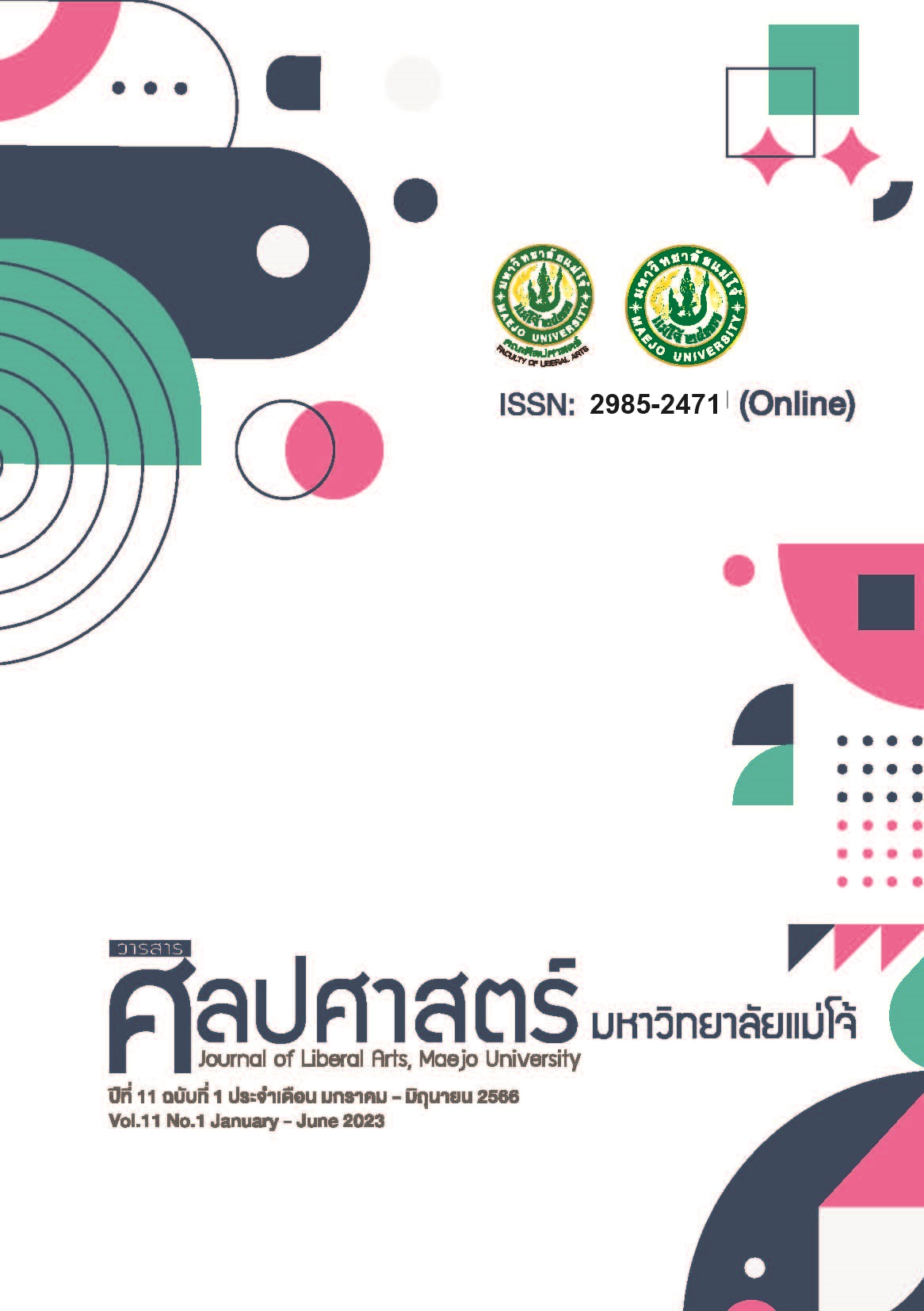การสัมผัสภาษาของแรงงานอพยพชาวไทใหญ่ที่อาศัยในอำเภอที่ติดกับเขตชานเมือง ของจังหวัดเชียงใหม่
Main Article Content
บทคัดย่อ
งานวิจัยนี้มีจุดประสงค์เพื่อวิเคราะห์การใช้ภาษาของแรงงานต่างด้าวชาวไทใหญ่เมื่อเกิดการสัมผัสภาษาในบริบทต่าง ๆ และวิเคราะห์ปรากฏการณ์ที่เกิดขึ้นซึ่งเป็นผลพวงจากการสัมผัสภาษานั้น โดยมีกลุ่มตัวอย่างที่ศึกษาจำนวนทั้งสิ้น 47 คน 3 รุ่นอายุ ได้มาด้วยวิธีการสุ่มแบบเจาะจง กลุ่มตัวอย่างทั้งหมดอาศัยและทำงานอยู่บริเวณพื้นที่รอยต่อระหว่างอำเภอเมืองกับอำเภอรอบๆ 3 อำเภอ คือ อำเภอหางดง อำเภอแม่ริม และอำเภอสันทราย เครื่องมือที่ใช้ในการเก็บข้อมูลคือแบบสัมภาษณ์โดยป้อนข้อคำถามกึ่งโครงสร้างลงในแอฟพลิเคชั่นที่ชื่อว่า Survey Monkey และสัมภาษณ์แบบไม่เป็นทางการ โดยใช้การสังเกตการณ์แบบไม่มีส่วนร่วมประกอบเพื่อยืนยันข้อมูล วิเคราะห์ข้อมูลด้วยวิธีการวิเคราะห์เชิงพรรณนา ผลการศึกษาเรื่องการใช้ภาษาพบว่า 1) แรงงานไทใหญ่เมื่อต้องมีปฏิสัมพันธ์กับคนนอกกลุ่มใช้คำเมืองมากที่สุด 2) แรงงานไทใหญ่ใช้ภาษาตนเองมากที่สุดในชีวิตประจำวัน 3) แรงงานไทใหญ่ใช้ภาษาไทใหญ่ทักษะฟังและพูดมากที่สุดในชีวิตประจำวัน 4) แรงงานไทใหญ่ใชคำเมืองถี่กว่าภาษาไทยกลางกลาง 5) แรงงานไทใหญ่สามารถพูดภาษาพม่า ภาษาอังกฤษ ภาษากระเหรี่ยงและภาษาจีนได้ 6) แรงงานไทใหญ่รุ่นที่ 1 เลือกใช้ภาษาของตนเองมากที่สุดในการสื่อสารกับบุคคลในครอบครัว 7) ภาษาไทใหญ่ถูกเลือกใช้ในบริบทที่กว้างที่สุดคือ บริบทที่เกี่ยวข้องกับศาสนา บริบทที่เป็นส่วนตัว และบริบทชีวิตประจำวันทั่วไป ภาษาไทยกลางถูกเลือกใช้มากที่สุด (พอๆกับภาษาไทใหญ่) เวลาที่ฟังวิทยุและเวลานับเลข คำเมืองถูกใช้มากที่สุดเมื่ออยู่ในที่สาธารณะ เช่น ตลาด โรงพยาบาล วัด 8) แรงงานไทใหญ่ใช้ภาษาไทใหญ่และภาษาไทยกลางในสื่อออนไลน์เท่าๆกัน และสุดท้ายปรากฏการณ์ที่เกิดขึ้นซึ่งเป็นผลพวงจากการสัมผัสภาษาที่พบได้บ่อยที่สุดคือการปนคำ และเริ่มปรากฏการเลือกใช้ภาษาไทยกลางมากกว่าที่จะเลือกใช้คำเมือง ในกลุ่มแรงงานบางคน อีกทั้งพบข้อสังเกตบางประการที่อาจมีแนวโน้มเป็นภาษาคำเมืองใหม่
Article Details

อนุญาตภายใต้เงื่อนไข Creative Commons Attribution-NonCommercial-NoDerivatives 4.0 International License.
ต้นฉบับที่ได้รับการตีพิมพ์ในวารสารคณะศิลปศาสตร์ มหาวิทยาลัยแม่โจ้ ถือเป็นกรรมสิทธิ์ของมหาวิทยาลัยแม่โจ้ ห้ามนำข้อความทั้งหมดหรือบางส่วนไปพิมพ์ซ้ำ เว้นเสียแต่จะได้รับอนุญาตจากมหาวิทยาลัยฯ เป็นลายลักษณ์อักษรเอกสารอ้างอิง
ธงชัย ภูวนาถวิจิตร อัจฉรา สโรบล และปรีชา วงศ์ทิพย์. (2017). แนวโน้มทิศทางการย้ายถิ่นของแรงงานข้ามชาติและการจัดการเพื่อรองรับการรวมกลุ่มประชาคมอาเซียน: กรณีศึกษาแรงงานไทใหญ่ในอำเภอเมือง จังหวัดเชียงใหม่. มนุษยศาสตร์สาร. 18(2), 245-276. สืบค้น4 เมษายน 2566 จาก https://so03.tci-thaijo.org/index.php/JHUMANS/article/view/128204/96439
บรรจบ พันธุเมธา. (2507). ลักษณะภาษาไทยใหญ่เทียบกับภาษาไทยกรุงเทพฯ. สังคมศาสตร์ปริทัศน์ ฉบับพิเศษ. สืบค้น 12 เมษายน 2566 จาก, file:///Users/macair/Downloads/%E0%B8%9A%E0%B8%A3%E0%B8%A3%E0%B8%88%E0%B8%9A%20%E0%B8%A0%E0%B8%B2%E0%B9%84%E0%B8%97%E0%B8%A2%E0%B9%83%E0%B8%AB%E0%B8%8D%E0%B9%88.pdf
ปณิธิ อมาตยกุล. (2547). การย้ายถิ่นของชาวไทใหญ่เข้ามาในจังหวัดเชียงใหม่. (วิทยานิพนธ์ปริญญามหาบัณฑิต) เชียงใหม่: มหาวิทยาลัยเชียงใหม่. สืบค้น 3 มีนาคม 2562, จากhttp://www.sac.or.th/databases/ ethnicredb/research_detail_print.php?id=999
ปุ่น เที่ยงบูรณธรรม อรรฆพจน์ วงศ์พึ่งไชย และจุฑาทิพย์ เฉลิมพล. (ม.ป.ป.). สถานการณ์และแนวโน้มการขยายตัวของเมืองเชียงใหม่. สืบค้น 4 เมษายน 2566, จาก https://www.tei.or.th/thaicityclimate/public/work-19.pdf
สมทรง บุรุษพัฒน์, สุจริตลกษณ์ ดีผดุง, สุมิตรา สุรรัตน์เดชา, ปัทมา พัฒน์พงษ์, ณรงค์ อาจสมิติ, พิเชษ สีตะพงศ์. (2552). การใช้ภาษาและทัศนคติต่อภาษาและการท่องเที่ยวเชิงชาติพันธุ์ของกลุ่มชาติพันธุ์ในภูมิภาคตะวันตกของประเทศไทย. นครปฐม: สถาบันวิจัยภาษาและวัฒนธรรมเอเชีย มหาวิทยาลยมหิดล.
สำนักงานจัดหางานจังหวัดเชียงใหม่. (2561). จำนวนคนต่างด้าวที่ได้รับอนุญาตทำงานในท้องที่จังหวัดเชียงใหม่ [PDF document].
อัมพร จิรัฐติกร. (2558). การเมืองเรื่องพื้นที่สาธารณะของแรงงานอพยพชาวไทใหญ่ในจังหวัดเชียงใหม่ (รายงานวิจัยฉบับสมบูรณ์). กรุงเทพฯ: สำนักงานกองทุนสนับสนุนการวิจัย.
อัมพร จิรัฐติกร. (2562). พื้นที่สาธารณะข้ามชาติ การเมืองเรื่องพื้นที่ของแรงงานอพยพไทใหญ่ในจังหวัดเชียงใหม่. เชียงใหม่: ศูนย์วิจัยและบริการวิชาการ คณะสังคมศาสตร์มหาวิทยาลัยเชียงใหม่
Dechapratumwan, P. (2016). Language Choice and Code-Switching in Casual Conversations of Tai Dam Bilinguals. Journal of the Southeast Asian Linguistics Society. 9, 1-29.
Gardner-Chloros, P. (2013). Language Diversity and Contact. In L. Wei (Ed.), Applied Linguistics. Oxford: John Wiley Blackwell & Sons. Retrieved 30 November 2019 from https://vulms.vu.edu.pk/ Courses/ENG522/ Downloads/(Introducing%20Linguistics)%20Li%20Wei%20(ed.)Applied%20 Linguistics-Wiley-Blackwell..pdf
Grosjean, F. (1982). Life and Reality. Cambridge: Harvard University Press.
Gumperz, J. (1982). Language and Social Identity. Cambridge: Cambridge University Press.
Heller, M. (1988). Polylingualism as reality and norm. Journal of Pragmatics. 12(4), 445-465.
Li, W. (1992). Language Choice and Language Shift in a Chinese Community in Britain. PhD. Dissertation. University of Newcastle Upon Tyne.
Li, W., Lesley, M., Pong, S. (1992). A two-step sociolinguistic analysis of code-switching and language choice: the example of a bilingual Chinese community in Britain. International Journal of Applied Linguistics. 2(1), 68-86. Retrieved 10 April 2019 from https://doi.org/10.1111/j.1473-4192.1992.tb00024.x
Li, W. (1994). Three Generations, Two Languages, One Family. Clevedon: Multilingual Matters.
Li, W.(editor). (2000). The Bilingualism reader. London; New York : Routledge.
Lim, L., & Ansaldo, U. (2016). Languages in contact. Cambridge: Cambridge University Press.
Matras, Y. (2009). Language contact. Cambridge: Cambridge University Press.
Milroy, L & Muysken, P. (1995). One speaker, two languages: cross- disciplinary
perspectives on code-switching. Cambridge: Cambridge University Press.
Myers-Scotton, C. (1993). Social motivation for code-switching: Evidence from Africa. Oxford: Clarendon.
Poplack, S. (2004). Code-switching. In Ammon, U., Dittmar, N., Mattheier, K.J. & Trudgill, P. (eds.), Sociolinguistics/ Soziolinguistik: An international handbook of the science of language. (2nd ed.). Berlin: Walter de Gruyter. 589.
Poplack, S. & Vanniarajan. (1991). The empirical study of code-switching, Papers for the Symposium on Code-switching in Bilingual Studies: Theory, Significance and Perspectives. Strasbourg: European Science Foundation. 181-206

